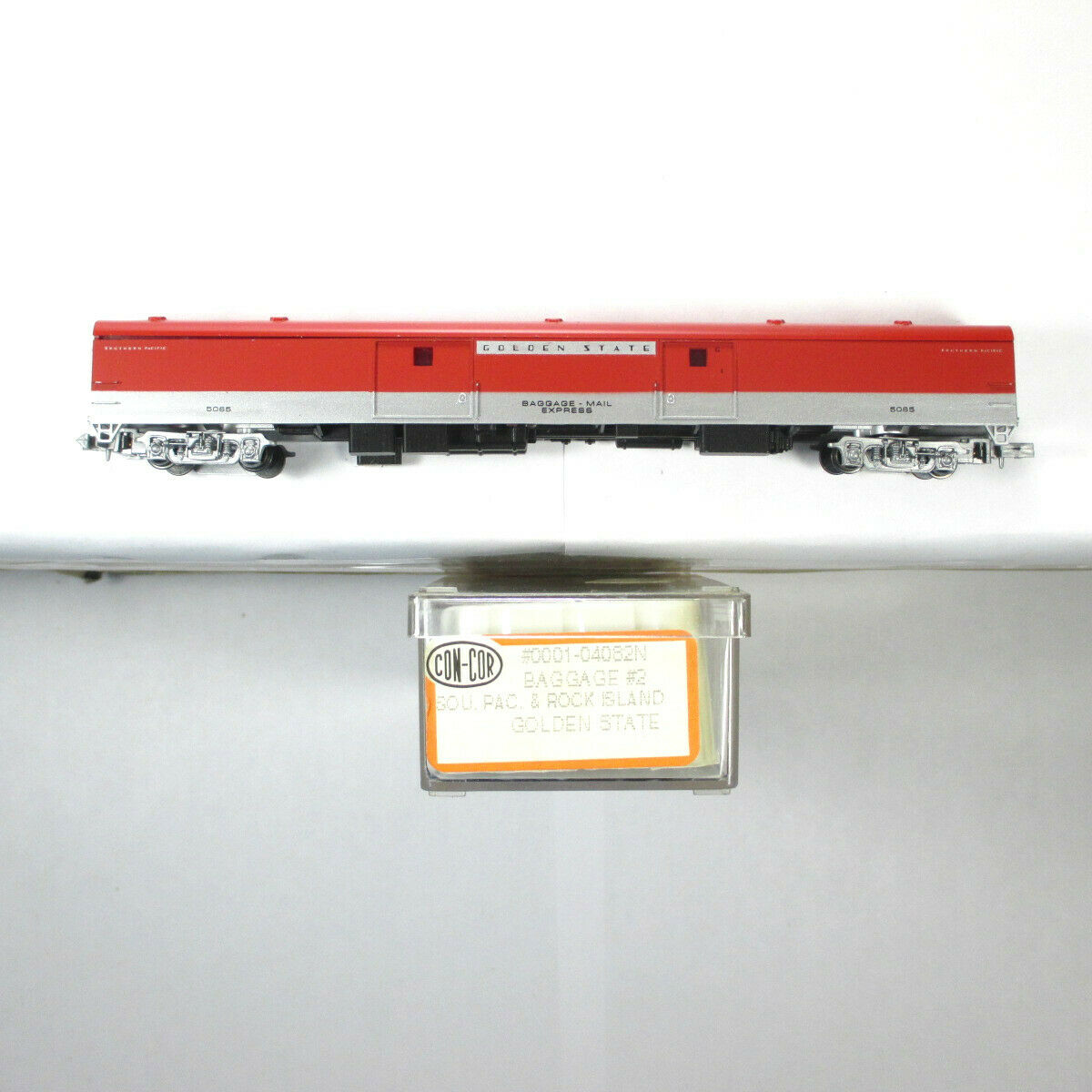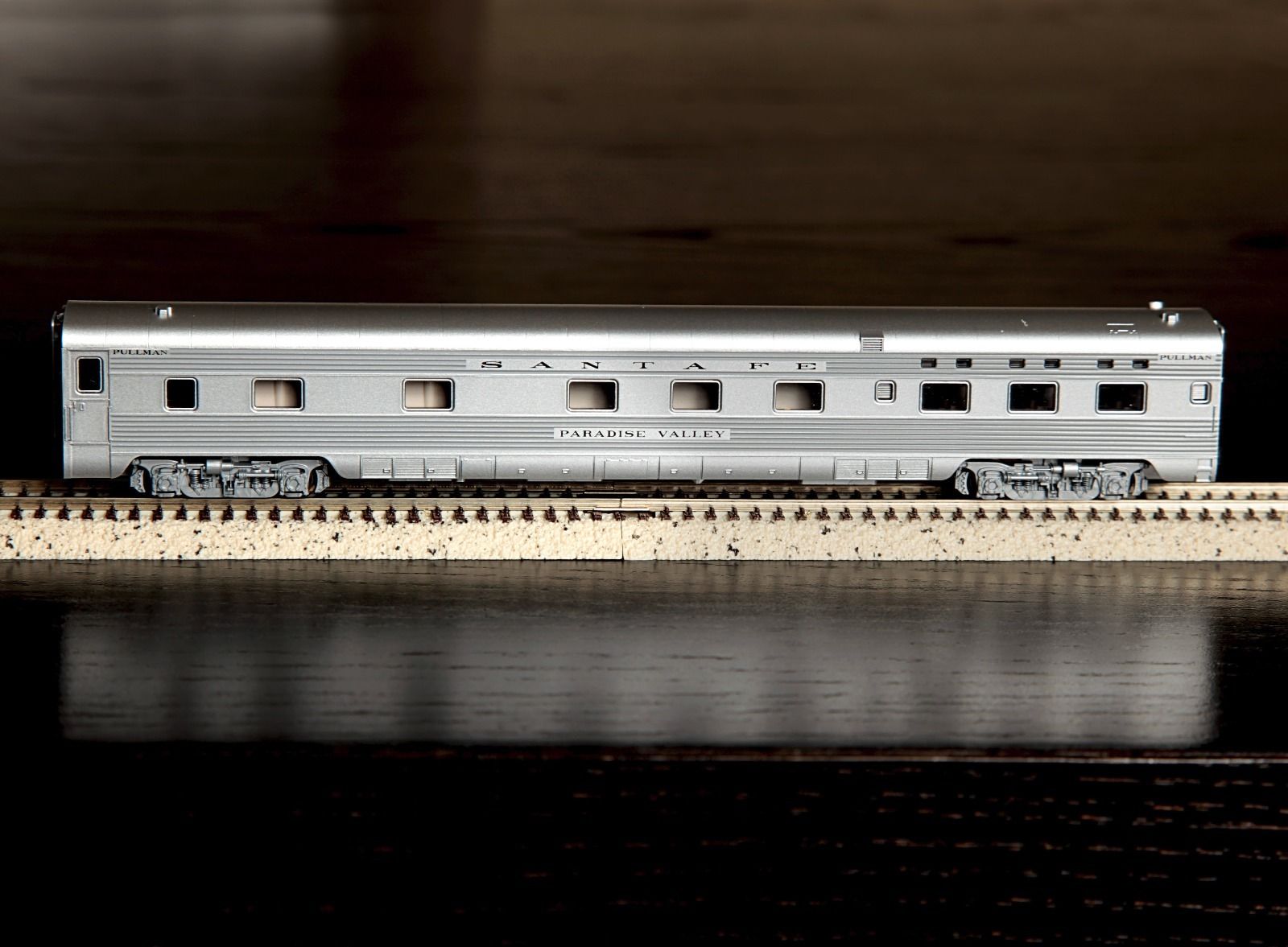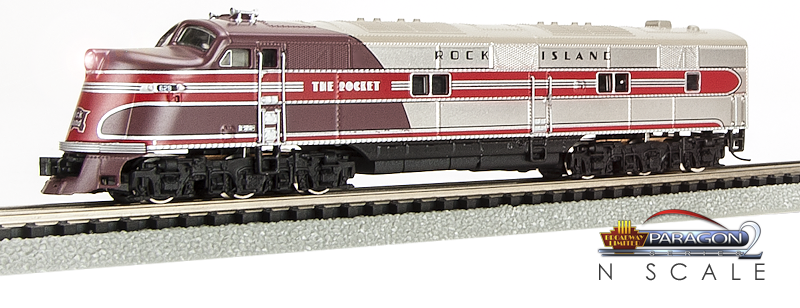Model Information: This model has been around for a while. The originals were produced by Kato Japan operating as Sekisui Kinzoku. Later versions were made in China. The models are based on prototypes from the late 1950's and reasonably accurate though somewhat "generic".
This baggage car model is a close match to Great Northern’s baggage cars, which they rebuilt from heavyweight passenger cars from 1947 through the early 50’s.
As of 2016, these have been produced in 40 road names across 7 different varieties for a total of 280 cars. Each road name has a Baggage-Mail, Baggage, Coach, Sleeper, Dome, Diner and Observation variety
The models are currently available in both Micro-Trains Magnetmatic couplers as well as Con-Cor's "Rigid Face" couplers. They are fully assembled "RTR" models with detailed interiors, and add-on lighting kits are separately available.
This baggage car model is a close match to Great Northern’s baggage cars, which they rebuilt from heavyweight passenger cars from 1947 through the early 50’s.
As of 2016, these have been produced in 40 road names across 7 different varieties for a total of 280 cars. Each road name has a Baggage-Mail, Baggage, Coach, Sleeper, Dome, Diner and Observation variety
The models are currently available in both Micro-Trains Magnetmatic couplers as well as Con-Cor's "Rigid Face" couplers. They are fully assembled "RTR" models with detailed interiors, and add-on lighting kits are separately available.
Prototype History: Great Northern’s baggage cars were rebuilt from heavyweight passenger cars from 1947 through the early 50’s. Though the Great Northern ordered RPO cars new from AC&F and PS during 1947-1951, baggage cars were rebuilt from old heavyweight cars. Thus GN had a variety of lengths (74' to 85'), trucks, doors, door spacing, and roofs.
GN rebuilt baggage cars roster here on the Friends of BN Railroad website.
GN rebuilt baggage cars roster here on the Friends of BN Railroad website.
Road Name History: The Chicago, Rock Island and Pacific Railroad (CRI&P RR) (reporting marks RI, ROCK) was a Class I railroad in the United States. It was better known as the Rock Island Line, or, in its final years, The Rock. At the end of 1970 it operated 7183 miles of road on 10669 miles of track; that year it reported 20557 million ton-miles of revenue freight and 118 million passenger-miles. (Those totals may or may not include the former Burlington-Rock Island Railroad.)
Its predecessor, the Rock Island and La Salle Railroad Company, was incorporated in Illinois on February 27, 1847, and an amended charter was approved on February 7, 1851, as the Chicago and Rock Island Railroad. Construction began October 1, 1851, in Chicago, and the first train was operated on October 10, 1852, between Chicago and Joliet. Construction continued on through La Salle, and Rock Island was reached on February 22, 1854, becoming the first railroad to connect Chicago with the Mississippi River.
In 1980 Rock Island was liquidated. The railroad's locomotives, rail cars, equipment, tracks, and real estate were sold to other railroads or to scrappers. William Gibbons (the trustee) was able to raise more than $500 million in the liquidation, paying off all the railroad's creditors, bondholders and all other debts in full at face value with interest. Henry Crown was ultimately proven correct, as both he and other bondholders who had purchased Rock Island debt for cents on the dollar during the low ebb in prices did especially well.
Read more on Wikipedia and Rock Island Technical Society.
Its predecessor, the Rock Island and La Salle Railroad Company, was incorporated in Illinois on February 27, 1847, and an amended charter was approved on February 7, 1851, as the Chicago and Rock Island Railroad. Construction began October 1, 1851, in Chicago, and the first train was operated on October 10, 1852, between Chicago and Joliet. Construction continued on through La Salle, and Rock Island was reached on February 22, 1854, becoming the first railroad to connect Chicago with the Mississippi River.
In 1980 Rock Island was liquidated. The railroad's locomotives, rail cars, equipment, tracks, and real estate were sold to other railroads or to scrappers. William Gibbons (the trustee) was able to raise more than $500 million in the liquidation, paying off all the railroad's creditors, bondholders and all other debts in full at face value with interest. Henry Crown was ultimately proven correct, as both he and other bondholders who had purchased Rock Island debt for cents on the dollar during the low ebb in prices did especially well.
Read more on Wikipedia and Rock Island Technical Society.
Brand/Importer Information: Con-Cor has been in business since 1962. Many things have changed over time as originally they were a complete manufacturing operation in the USA and at one time had upwards of 45 employees. They not only designed the models,but they also built their own molds, did injection molding, painting, printing and packaging on their models.
Currently, most of their manufacturing has been moved overseas and now they import 90% of their products as totally finished goods, or in finished components. They only do some incidental manufacturing today within the USA.
Important Note: The Con-Cor product numbering can be very confusing. Please see here in the article how to properly enter Con-Cor stock numbers in the TroveStar database.
Currently, most of their manufacturing has been moved overseas and now they import 90% of their products as totally finished goods, or in finished components. They only do some incidental manufacturing today within the USA.
Important Note: The Con-Cor product numbering can be very confusing. Please see here in the article how to properly enter Con-Cor stock numbers in the TroveStar database.
Item created by: gdm on 2019-07-10 08:57:36. Last edited by Alain LM on 2020-11-10 13:23:59
If you see errors or missing data in this entry, please feel free to log in and edit it. Anyone with a Gmail account can log in instantly.
If you see errors or missing data in this entry, please feel free to log in and edit it. Anyone with a Gmail account can log in instantly.











